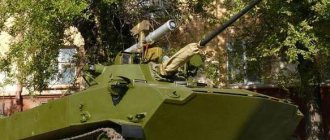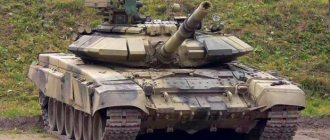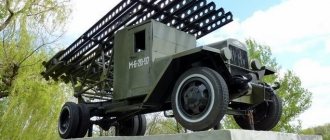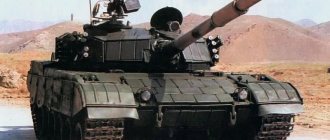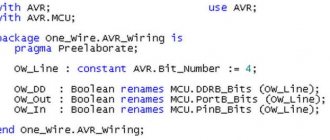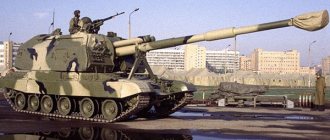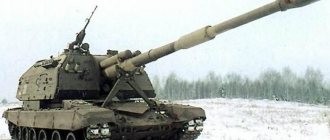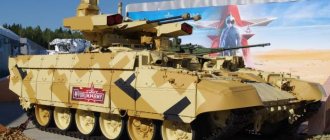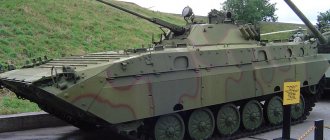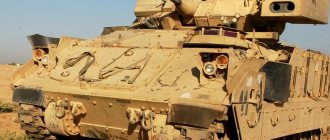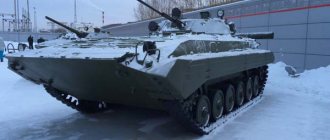The famous fighting vehicle in museums, films and computer games.
On July 14, 1941, not far from the railway station in the city of Orsha, the famous battery of Captain Ivan Flerov attacked the enemy for the first time. The battery was armed with completely new, unknown to the Germans, BM-13 combat vehicles, which the soldiers would affectionately call “Katyushas”.
At that time, few people knew that these vehicles would take part in the most important battles of the Great Patriotic War and, along with the legendary T-34 tanks, would become a symbol of victory in this terrible war. However, both Russian and German soldiers and officers were able to appreciate their power after the first shots.
The story is told by Mikhail Myagkov, professor at the Academy of Military Sciences of the Russian Federation, scientific director of the Russian Military Historical Society .
First operation
Information about the number of vehicles in service with the battery varies: according to one version, there were four of them, according to another - five or seven. But we can definitely say that the effect of their use was stunning. At the station, military equipment and trains and, according to our data, a battalion of German infantry, as well as important military property, were destroyed. The explosion was so strong that Franz Halder, Chief of the General Staff of the German Ground Forces, wrote in his diary that the ground melted where the shells hit.
Flerov’s battery was transferred to the Orsha area, as information was received that a large amount of cargo important for the German side had accumulated at this station. There is a version that in addition to the German units that arrived there, secret weapons of the USSR remained at the station, which they did not have time to take to the rear. It had to be quickly destroyed so that the Germans did not get it.
To carry out this operation, a special tank group was created, which supported the battery as it moved towards Orsha through territory already abandoned by Soviet troops. That is, the Germans could capture it at any moment; it was a very dangerous, risky enterprise. When the battery was just preparing to leave, the designers strictly ordered that the BM-13 be blown up in the event of retreat and encirclement, so that the vehicles would never fall to the enemy.
The soldiers will carry out this order later. During the retreat near Vyazma, the battery was surrounded, and on the night of October 7, 1941, it was ambushed. Here the battery, having fired its last salvo, was blown up by order of Flerov. The captain himself died, he was posthumously awarded the Order of the Patriotic War, 1st degree, in 1942, and in 1995 he became a Hero of Russia.
Katyusha - a unique combat vehicle of the USSR
On July 14, 1941, in one of the defense sectors the 20th Army, in the forest east of Orsha, flames shot up into the sky, accompanied by an unusual roar, not at all similar to the shots of artillery guns. Clouds of black smoke rose above the trees, and barely visible arrows hissed in the sky towards the German positions.
Soon the entire area of the local station, captured by the Nazis, was engulfed in furious fire. The Germans, stunned, ran in panic. It took the enemy a long time to rally his demoralized units. the Katyushas announced themselves for the first time in history .
The first combat use of a new type of powder rockets by the Red Army dates back to the battles at Khalkhin Gol. On May 28, 1939, Japanese troops that occupied Manchuria, in the area of the Khalkhin Gol River, launched an offensive against Mongolia, with which the USSR was bound by a mutual assistance treaty. A local, but no less bloody war began. And here, in August 1939, a group of I-16 under the command of test pilot Nikolai Zvonarev first used RS-82 missiles.
The Japanese initially decided that their planes were attacked by a well-camouflaged anti-aircraft gun. Only a few days later, one of the officers who took part in the air battle reported: “Under the wings of Russian aircraft, I saw bright flashes of flame!”
"Katyusha" in a combat position
Experts flew in from Tokyo, examined the damaged aircraft and agreed that such destruction could only be caused by a shell with a diameter of at least 76 mm. But calculations showed that an aircraft capable of withstanding the recoil of a gun of this caliber simply could not exist! Only experimental fighters tested 20 mm guns. To find out the secret, a real hunt was announced for the planes of Captain Zvonarev and his comrades, pilots Pimenov, Fedorov, Mikhailenko and Tkachenko. But the Japanese failed to shoot down or land at least one car.
The results of the first use of missiles launched from aircraft exceeded all expectations. In less than a month of fighting (a truce was signed on September 15), the pilots of Zvonarev’s group flew 85 combat missions and shot down 13 enemy aircraft in 14 air battles!
The missiles that proved so successful on the battlefield were developed from the early 1930s at the Jet Research Institute (RNII), which was headed by the chemist Boris Slonimer after the repressions of 1937-1938. Yuri Pobedonostsev , who now has the honor of being called their author, worked directly on the rockets
The success of the new weapon spurred work on the first version of a multi-charge unit, which later turned into the Katyusha. At NII-3 of the People's Commissariat of Ammunition, as the RNII was called before the war, this work was led by Andrei Kostikov as chief engineer. Modern historians speak rather disrespectfully of Kostikov. And this is fair, because the archives revealed his denunciations against his colleagues (the same as Pobedonostsev).
The first version of the future Katyusha was loaded with 132 mm shells, similar to those that Captain Zvonarev fired at Khalkhin Gol. The entire installation with 24 guides was mounted on a ZIS-5 truck. Here the authorship belongs to Ivan Gvai, who had previously made the “Flute” - an installation for rockets on the I-15 and I-16 fighters. The first field tests near Moscow, carried out at the beginning of 1939, revealed many shortcomings.
Military experts, who approached the assessment of rocket artillery from the standpoint of barrel artillery, saw these strange machines as a technical curiosity. But, despite the ridicule of the artillerymen, the institute’s staff continued to work hard on the second version of the launcher. It was installed on a more powerful ZIS-6 truck. However, 24 guides, mounted across the vehicle, as in the first version, did not ensure stability of the vehicle when firing.
Field tests of the second option were carried out in the presence of Marshal Klim Voroshilov . Thanks to his favorable assessment, the development team received support from the command staff. At the same time, designer Galkovsky proposed a completely new option: leave 16 guides and mount them longitudinally on the machine. In August 1939, the pilot plant was manufactured.
By that time, a group led by Leonid Shvarts had designed and tested samples of new 132-mm missiles. In the fall of 1939, another series of tests was carried out at the Leningrad artillery range. This time, the launchers and their shells were approved. From that moment on, the rocket launcher became officially known as BM-13 , which meant “combat vehicle”, and 13 was an abbreviation for the caliber of the 132-mm rocket.
The BM-13 combat vehicle was a chassis of a three-axle ZIS-6 vehicle, on which a rotary truss with a package of guides and a guidance mechanism was installed. For aiming, a rotating and lifting mechanism and an artillery sight were provided. At the rear of the combat vehicle there were two jacks, which ensured its greater stability when firing. The missiles were launched using a hand-held electric coil connected to a battery and contacts on the guides. When the handle was turned, the contacts closed in turn, and the starting squib was fired in the next projectile.
At the end of 1939, the Main Artillery Directorate of the Red Army gave an order to NII-3 for the production of six BM-13s. By November 1940, this order was completed. On June 17, 1941, the vehicles were demonstrated at a review of Red Army weapons that took place near Moscow. The BM-13 was inspected by Marshal Timoshenko, People's Commissar of Armaments Ustinov, People's Commissar of Ammunition Vannikov and Chief of the General Staff Zhukov. On June 21, following the results of the review, the command decided to launch the production of M-13 and BM-13 installations.
On the morning of June 22, 1941, employees of NII-3 gathered within the walls of their institute. It was clear: the new weapon would no longer undergo any military tests - now it was important to assemble all the installations and send them into battle. Seven BM-13 vehicles formed the backbone of the first rocket artillery battery, the decision to form which was made on June 28, 1941. And already on the night of July 2, she left under her own power for the Western Front.
The first battery consisted of a control platoon, a sighting platoon, three fire platoons, a combat supply platoon, a utility department, a fuel and lubricants department, and a medical unit. In addition to seven BM-13 launchers and a 122-mm howitzer of the 1930 model, which served for sighting, the battery had 44 trucks for transporting 600 M-13 rockets, 100 shells for a howitzer, an entrenching tool, three refills of fuels and lubricants, seven daily norms of food and other property.
Captain Ivan Andreevich Flerov - first commander of the experimental Katyusha battery
The command staff of the battery was staffed mainly by students of the Dzerzhinsky Artillery Academy, who had just graduated from the first year of the command department. Captain Ivan Flerov , an artillery officer with experience of the Soviet-Finnish war, was appointed commander of the battery. Neither the officers nor the numbers of the combat crews of the first battery had any special training; during the formation period they managed to conduct only three classes.
They were led by missile weapons developers, design engineer Popov and military engineer 2nd rank Shitov. Just before the end of class, Popov pointed to a large wooden box mounted on the running board of a combat vehicle. “When we send you to the front,” he said, “we will fill this box with sabers and put a squib, so that at the slightest threat of the enemy’s seizure of the rocket weapons, we can blow up both the installation and the shells.” Two days after leaving Moscow, the battery became part of the 20th Army of the Western Front, which fought for Smolensk.
On the night of July 12-13, she was alerted and sent to Orsha. At the Orsha station, many German trains with troops, equipment, ammunition and fuel accumulated. Flerov ordered the battery to be deployed five kilometers from the station, behind a hill. The engines of the vehicles were not turned off in order to immediately leave the position after the salvo. At 15:15 on July 14, 1941, Captain Flerov gave the command to open fire.
Here is the text of the report to the German General Staff: “The Russians used a battery with an unprecedented number of guns. The shells are high-explosive incendiary, but have an unusual effect. The troops fired at by the Russians testify: the fire raid is like a hurricane. The shells explode simultaneously. The loss of life is significant." The morale effect of the use of rocket mortars was stunning. The enemy lost more than an infantry battalion and a huge amount of military equipment and weapons at the Orsha station.
On the same day, Flerov’s battery fired at the crossing of the Orshitsa River, where a lot of Nazi manpower and equipment had also accumulated. In the following days, the battery was used in various directions of the 20th Army's operations as a fire reserve for the chief of artillery of the army. Several successful salvoes were fired at the enemy in the areas of Rudnya, Smolensk, Yartsevo, and Dukhovshina. The effect exceeded all expectations.
The German command tried to get samples of the Russian wonder weapons. The hunt began for Captain Flerov's battery, as once for Zvonarev's fighters. On October 7, 1941, near the village of Bogatyr, Vyazemsky district, Smolensk region, the Germans managed to surround the battery. The enemy attacked her suddenly, on the march, firing from different sides. The forces were unequal, but the crews fought desperately, Flerov used up the last ammunition and then blew up the launchers.
Having led people to a breakthrough, he died heroically. 40 out of 180 people survived, and everyone who survived the death of the battery in October 1941 was declared missing, although they fought until the victory. Only 50 years after the first salvo of the BM-13, the field near the village of Bogatyr revealed its secret. There, the remains of Captain Flerov and 17 other rocket men who died with him were finally found. In 1995, by decree of the President of the Russian Federation, Ivan Flerov was posthumously awarded the title of Hero of Russia .
Flerov's battery was destroyed, but the weapon existed and continued to inflict damage on the advancing enemy. In the first days of the war, the production of new installations began at the Moscow plant. There was no need to customize the designers either. In a matter of days, they completed the development of a new combat vehicle for 82-mm projectiles - the BM-8. It began to be produced in two versions: one - on the chassis of a ZIS-6 car with 6 guides, the other - on the chassis of an STZ tractor or T-40 and T-60 tanks with 24 guides.
Obvious successes at the front and in production allowed the Headquarters of the Supreme High Command to decide already in August 1941 to form eight regiments of rocket artillery, which, even before participating in the battles, were given the name “guards mortar regiments of the reserve artillery of the Supreme High Command.” This emphasized the special importance attached to the new type of weapons. The regiment consisted of three divisions, the division - of three batteries, four BM-8 or BM-13 in each.
For the 82 mm caliber rocket, guides were developed and manufactured, which were later installed on the chassis of the ZIS-6 vehicle (36 guides) and on the chassis of the T-40 and T-60 light tanks (24 guides). Special launchers for 82 mm and 132 mm caliber missiles were manufactured for their subsequent installation on warships - torpedo boats and armored boats.
The production of BM-8 and BM-13 was continuously growing, and the designers were developing a new 300-mm M-30 rocket weighing 72 kg and with a firing range of 2.8 km. They received the nickname “Andryusha” among the people. They were launched from a launching machine (“frame”) made of wood. The launch was carried out using a sapper blasting machine. “Andryushas” were first used in Stalingrad. The new weapons were easy to manufacture, but installing them in position and aiming at the target required a lot of time. In addition, the short range of M-30 missiles made them dangerous for their own crews. Subsequently, combat experience showed that the M-30 is a powerful offensive weapon, capable of destroying bunkers, trenches with canopies, stone buildings and other fortifications. There was even an idea to create a mobile anti-aircraft missile system based on Katyushas to destroy enemy aircraft, but the pilot installation was never brought to production.
The effectiveness of the combat use of Katyushas during an attack on an enemy fortified unit can be illustrated by the example of the defeat of the Tolkachev defensive unit during our counteroffensive near Kursk in July 1943. The village of Tolkachevo was turned by the Germans into a heavily fortified resistance center with a large number of dugouts and bunkers of 5-12 rolls, with a developed network of trenches and communication passages. The approaches to the village were heavily mined and covered with wire fences. Salvos of rocket artillery destroyed a significant part of the bunkers, the trenches, along with the enemy infantry in them, were filled up, and the fire system was completely suppressed. Of the entire garrison of the node, numbering 450-500 people, only 28 survived. The Tolkachevsky node was taken by our units without any resistance.
By the beginning of 1945, 38 separate divisions, 114 regiments, 11 brigades and 7 divisions armed with rocket artillery were operating on the battlefields. But there were also problems. Mass production of launchers was quickly established, but widespread use of Katyushas was held back due to a lack of ammunition. There was no industrial base for the production of high-quality gunpowders for projectile engines. Ordinary gunpowder could not be used in this case - special grades with the required surface and configuration, time, character and combustion temperature were required. The deficit was limited only by the beginning of 1942, when factories transferred from west to east began to pick up the required production rates. During the entire Great Patriotic War, Soviet industry produced more than ten thousand rocket artillery combat vehicles.
Origin of the name Katyusha
It is known why BM-13 installations began to be called “guards mortars” at one time. The BM-13 installations were not actually mortars, but the command sought to keep their design secret for as long as possible. When, at a firing range, soldiers and commanders asked a GAU representative to name the “true” name of the combat installation, he advised: “Call the installation as an ordinary artillery piece. This is important for maintaining secrecy."
There is no single version of why the BM-13 began to be called “Katyusha”. There are several assumptions: 1. Based on the name of Blanter’s song, which became popular before the war, based on the words of Isakovsky, “Katyusha”. The version is convincing, since the battery first fired on July 14, 1941 (on the 23rd day of the war) at a concentration of fascists on Bazarnaya Square in the city of Rudnya, Smolensk region. She was shooting from a high, steep mountain - the association with the high, steep bank in the song immediately arose among the fighters. Finally, the former sergeant of the headquarters company of the 217th separate communications battalion of the 144th Infantry Division of the 20th Army, Andrei Sapronov, is alive, now a military historian, who gave it this name. Red Army soldier Kashirin, having arrived with him at the battery after the shelling of Rudnya, exclaimed in surprise: “What a song!” “Katyusha,” answered Andrei Sapronov (from the memoirs of A. Sapronov in the Rossiya newspaper No. 23 of June 21-27, 2001 and in the Parliamentary Gazette No. 80 of May 5, 2005). Through the communications center of the headquarters company, the news about a miracle weapon called “Katyusha” within 24 hours became the property of the entire 20th Army, and through its command - the entire country. On July 13, 2011, the veteran and “godfather” of Katyusha turned 90 years old.
2. There is also a version that the name is associated with the “K” index on the mortar body - the installations were produced by the Kalinin plant (according to another source - by the Comintern plant). And front-line soldiers loved to give nicknames to their weapons. For example, the M-30 howitzer was nicknamed “Mother”, the ML-20 howitzer gun was nicknamed “Emelka”. Yes, and the BM-13 was at first sometimes called “Raisa Sergeevna,” thus deciphering the abbreviation RS (missile).
3. The third version suggests that this is how the girls from Moscow who worked on the assembly dubbed these cars. Another, exotic version. The guides on which the projectiles were mounted were called ramps. The forty-two-kilogram projectile was lifted by two fighters harnessed to the straps, and the third usually helped them, pushing the projectile so that it lay exactly on the guides, and he also informed those holding that the projectile stood up, rolled, and rolled onto the guides. It was allegedly called “Katyusha” (the role of those holding the projectile and the one rolling it was constantly changing, since the crew of the BM-13, unlike cannon artillery, was not explicitly divided into loader, aimer, etc.)
4. It should also be noted that the installations were so secret that it was even forbidden to use the commands “fire”, “fire”, “volley”, instead they sounded “sing” or “play” (to start it was necessary to turn the handle of the electric coil very quickly) , which may also have been related to the song “Katyusha”. And for our infantry, a salvo of Katyusha rockets was the most pleasant music.
5. There is an assumption that initially the nickname “Katyusha” was a front-line bomber equipped with rockets - an analogue of the M-13. And the nickname jumped from an airplane to a rocket launcher through shells.
And more interesting facts about the names of BM-13:
In the German troops, these machines were called “Stalin’s organs” due to the external resemblance of the rocket launcher to the pipe system of this musical instrument and the powerful, stunning roar that was produced when the missiles were launched.
During the battles for Poznan and Berlin, the M-30 and M-31 single-launch installations received the nickname “Russian Faustpatron” from the Germans, although these shells were not used as an anti-tank weapon. With “dagger” (from a distance of 100-200 meters) launches of these shells, the guards broke through any walls.
If Hitler's oracles had looked more closely at the signs of fate, then surely July 14, 1941 would have become a landmark day for them. It was then that in the area of the Orsha railway junction and the crossing of the Orshitsa River, Soviet troops first used BM-13 combat vehicles, which received the affectionate name “Katyusha” among the army. The result of two salvos at the accumulation of enemy forces was stunning for the enemy. German losses fell under the “unacceptable” heading.
Here are excerpts from a directive to the troops of Hitler's high military command: “The Russians have an automatic multi-barrel flamethrower cannon... The shot is fired by electricity... During the shot, smoke is generated...” The obvious helplessness of the wording testified to the complete ignorance of the German generals regarding the design and technical characteristics of the new Soviet weapon - the rocket-propelled mortar.
A striking example of the effectiveness of the Guards mortar units, and their basis was “Katyushas,” can be seen in the lines from the memoirs of Marshal Zhukov: “The rockets, by their actions, caused complete devastation. I looked at the areas where shelling was carried out and saw the complete destruction of defensive structures ... "
The Germans developed a special plan to seize new Soviet weapons and ammunition. In the late autumn of 1941 they managed to do this. The “captive” mortar was truly “multi-barreled” and fired 16 rocket mines. Its firepower was several times more effective than the mortar used by the fascist army. Hitler's command decided to create equivalent weapons.
The Germans did not immediately understand that the Soviet mortar they captured was a truly unique phenomenon, opening a new page in the development of artillery, the era of multiple launch rocket systems (MLRS).
We must pay tribute to its creators - scientists, engineers, technicians and workers of the Moscow Jet Research Institute (RNII) and related enterprises: V. Aborenkov, V. Artemyev, V. Bessonov, V. Galkovsky, I. Gvai, I. Kleimenov, A. Kostikov, G. Langemak, V. Luzhin, A. Tikhomirov, L. Schwartz, D. Shitov.
The main difference between the BM-13 and similar German weapons was its unusually bold and unexpected concept: mortarmen could reliably hit all targets in a given square with relatively inaccurate rocket-propelled mines. This was achieved precisely due to the salvo nature of the fire, since every point of the area under fire necessarily fell into the affected area of one of the shells. German designers, realizing the brilliant “know-how” of Soviet engineers, decided to reproduce, if not in the form of a copy, then using the main technical ideas.
It was in principle possible to copy the Katyusha as a combat vehicle. Insurmountable difficulties arose when trying to design, test and establish mass production of similar missiles. It turned out that German gunpowder cannot burn in the chamber of a rocket engine as stably and steadily as Soviet ones. The analogues of Soviet ammunition designed by the Germans behaved unpredictably: they either sluggishly left the guides only to immediately fall to the ground, or they began flying at breakneck speed and exploded in the air from an excessive increase in pressure inside the chamber. Only a few successfully reached the target.
The point turned out to be that for effective nitroglycerin powders, which were used in Katyusha shells, our chemists achieved a spread in the values of the so-called heat of explosive transformation of no more than 40 conventional units, and the smaller the spread, the more stable the gunpowder burns. Similar German gunpowder had a spread of this parameter, even in one batch, above 100 units. This led to unstable operation of the rocket engines.
The Germans did not know that ammunition for the Katyusha was the fruit of more than ten years of activity by the RNII and several large Soviet research teams, which included the best Soviet gunpowder factories, outstanding Soviet chemists A. Bakaev, D. Galperin, V. Karkina, G. Konovalova, B Pashkov, A. Sporius, B. Fomin, F. Khritinin and many others. They not only developed the most complex formulations of rocket propellants, but also found simple and effective methods for their mass, continuous and cheap production.
At a time when at Soviet factories, according to ready-made drawings, the production of guards rocket mortars and shells for them was being expanded at an unprecedented pace and literally daily was increasing, the Germans had yet to conduct research and design work on the MLRS. But history has not given them time for this.
The article was written based on materials from the book Nepomnyashchiy N.N. “100 great secrets of the Second World War”, M., “Veche”, 2010, p. 152-157.
The image of the BM-13 (“Katyusha”) is actively used in video games about the Second World War:
BM-13 (“Katyusha”) in the computer game Company of Heroes 2
BM-13 salvo in the computer game “Behind Enemy Lines - 2”
Vehicle BM-13 (Katyusha)
A Katyusha salvo in the computer game War Front: Turning Point
About the history of the creation of rocket launchers
The development of rockets began in our country back in the 20s of the 20th century and was carried out by employees of the Gas Dynamics Institute. In the 1930s, research continued at the Rocket Research Institute, headed by Georgy Langemak. He was subsequently arrested and subjected to repression.
In 1939–1941, the jet systems were improved and tests were carried out. In March - June 1941 there was a display of the systems. The decision to create batteries that included new weapons was made literally a few hours before the start of the war: June 21, 1941. The armament of the first battery consisted of BM-13 vehicles with a 130 mm projectile. At the same time, the development of BM-8 vehicles was underway, and in 1943 the BM-31 appeared.
Chief designer
About those at sea: 7 naval museums
Museums of the Great Patriotic War
In addition to machines, special gunpowder was also developed. The Germans were hunting not only for our installations, but also for the composition of the gunpowder. They never managed to unravel his secret. The difference in the action of this gunpowder was that the German guns left a long trail of smoke, which was more than 200 meters - you could immediately understand where they were shooting from. We didn't have that kind of smoke.
These multiple launch rocket systems were prepared at (in peacetime it was a refrigeration equipment plant, which on the good side characterizes interchangeability in the field of heavy industry) and at Voronezh. And of course, in addition to the first battery of Captain Flerov, at the beginning of the war, other batteries were created, armed with rocket systems. It seems to modern researchers that at the very beginning of the war they were sent to guard headquarters. Most of them were sent to the Western Front to prevent the Germans from suddenly capturing the headquarters in order to overwhelm the enemy with fire and stop their advance.
Guard of the first months of the war
0
The first document on the formation of such a regiment was issued on August 4: a decree of the USSR State Committee for Defense ordered the formation of one guards mortar regiment armed with M-13 launchers. This regiment was named after the People's Commissar of General Mechanical Engineering Pyotr Parshin - the man who, in fact, approached the State Defense Committee with the idea of forming such a regiment. And from the very beginning he offered to give him the rank of Guards - a month and a half before the first Guards Rifle Units appeared in the Red Army, and then all the others. Four days later, on August 8, the staffing schedule for the Guards rocket launcher regiment was approved: each regiment consisted of three or four divisions, and each division consisted of three batteries of four combat vehicles. The same directive provided for the formation of the first eight regiments of rocket artillery. The ninth was the regiment named after People's Commissar Parshin. It is noteworthy that already on November 26, the People's Commissariat of General Engineering was renamed into the People's Commissariat of Mortar Weapons: the only one in the USSR that dealt with one single type of weapon (existed until February 17, 1946)! Isn't this evidence of the great importance the country's leadership attached to rocket mortars? Another evidence of this special attitude was the decree of the State Defense Committee, issued a month later - on September 8, 1941. This document actually turned rocket mortar artillery into a special, privileged type of armed forces. Guards mortar units were withdrawn from the Main Artillery Directorate of the Red Army and turned into guards mortar units and formations with their own command. It was directly subordinate to the Headquarters of the Supreme High Command, and included the headquarters, the weapons department of the M-8 and M-13 mortar units and operational groups in the main directions. The first commander of the guards mortar units and formations was military engineer 1st rank Vasily Aborenkov, a man whose name appeared in the author’s certificate for a “rocket launcher for a sudden, powerful artillery and chemical attack on the enemy using rocket shells.” It was Aborenkov, as first the head of the department and then the deputy head of the Main Artillery Directorate, who did everything to ensure that the Red Army received new, unprecedented weapons. After this, the process of forming new artillery units went into full swing. The main tactical unit was the regiment of guards mortar units. It consisted of three divisions of M-8 or M-13 rocket launchers, an anti-aircraft division, and service units. In total, the regiment consisted of 1,414 people, 36 BM-13 or BM-8 combat vehicles, and other weapons - 12 37 mm anti-aircraft guns, 9 DShK anti-aircraft machine guns and 18 light machine guns, not counting small arms of personnel. A salvo of one regiment of M-13 rocket launchers consisted of 576 rockets - 16 "eres" in a salvo of each vehicle, and a regiment of M-8 rocket launchers - of 1296 rockets, since one vehicle fired 36 projectiles at once.
About the nickname
Flerov's first battery took part in the battles for Smolensk, Dukhovshchina, Roslavl, Spas-Demensk. Other batteries, there were about five of them, were located in the area of the city of Rudni. And the first version about the origin of the nickname of these cars - “Katyusha” - is really connected with the song. The batteries fired a volley into Rudny Square, where the Germans were at that moment; one of the witnesses to what was happening allegedly said: “Yes, this is a song!” - and someone else confirmed: “Yes, like Katyusha.” And this nickname first migrated to the headquarters of the 20th Army, where the battery was located, and then spread throughout the country.
The second version about the “Katyusha” is connected with: the letter “K” was placed on the cars. This theory is supported by the fact that the soldiers nicknamed the M-20 howitzer with the letter “M” “Mother”. There are many other assumptions about the origin of the nickname “Katyusha”: someone believes that at the moment of the salvo the cars “sang” drawn out - the song of the same name also has a long chant; someone says that one of the cars had the name of a real woman written on it, and so on. But, by the way, there were other names. When the M-31 installation appeared, someone began to call it “Andryusha,” and the German Nebelwerfer mortar was nicknamed “Vanyusha.”
By the way, one of the names of the BM-13 among German soldiers was the nickname “Stalin’s organ”, because the guiding machines looked like pipes. And the sound itself, when the Katyusha “sang”, also resembled organ music.
BM-13 (Katyusha)
BM-13 (Katyusha)
BM-13 (Katyusha)
Why "Katyusha"?
There are several theories about the origin of the nickname “Katyusha”, which has gone down in history.
According to the first of them, “Katyusha” is a derivative of “KAT” (“Kostikov automatic thermite”) - markings on thermite shells created under the leadership of A. Kostikov. The existence of such shells has not been confirmed, nor is the fact that there was an unspoken agreement between Stalin and Hitler that the Wehrmacht would not use chemical weapons unless the Red Army used thermite shells. Probably, the myth about thermite shells appeared due to the unusual properties of fragments of high-explosive PCs to set fire to everything around them.
According to the second version, the first Katyushas arriving at the front from the Voronezh plant named after the Comintern were marked with the letter “K”. In addition, the song “Katyusha” was popular in those days.
Hence the nickname.
The third version suggests that one of the artillerymen wrote his girlfriend’s name on the car. The girl's name, of course, was Katya.
Planes, ships and sleighs
Rocket launchers of the BM-13 type (as well as BM-8 and BM-31) were mounted on airplanes, on ships, on boats, even on sleighs. In the corps of Lev Dovator, when he went on a raid against the German rear, these installations were located precisely on the sleigh.
"Katyusha" Flerov July 14, 1941
However, the classic version is, of course, a truck. When the cars first went into production, they were mounted on a ZIS-6 truck with three axles; when it was deployed into a combat position, two more jacks were installed at the rear for greater stability. But already from the end of 1942, especially in 1943, these guides increasingly began to be mounted on well-proven American Studebaker trucks supplied under Lend-Lease. They had good speed and maneuverability. By the way, this is one of the tasks of the system - to fire a salvo and quickly hide.
"Katyusha" truly became one of the main weapons of Victory. Everyone knows the T-34 tank and the Katyusha. Moreover, they know it not only in our country, but also abroad. When the USSR was negotiating Lend-Lease, exchanging information and equipment with the British and Americans, the Soviet side demanded the supply of radio equipment, radars, and aluminum. And the allies demanded Katyusha and T-34. The USSR gave us tanks, but I’m not sure about the Katyushas. Most likely, the Allies themselves figured out how these machines were made, but you can create an ideal model and not be able to organize mass production.
Museums where you can see the BM-13
Victory Museum
Moscow
The museum is an integral and at the same time the main part of the Victory memorial complex on Poklonnaya Hill in Moscow. On its territory there is an exhibition of weapons, military equipment and engineering structures (Victory weapons, captured equipment, railway troops, military highway, artillery, armored vehicles, air force, navy). Among the museum's exhibits are rare aircraft, one flying one - the U-2, the best tank of the Second World War, the T-34, and, of course, the legendary BM-13 (Katyusha).
Center for military-patriotic education "Museum-Diorama"
Voronezh
The Center for Military Patriotic Education opened in 2000. The museum's collection includes about 2,600 exhibits, including historical relics and replicas on the history of Russia and the Voronezh region. The exhibition space includes four halls and seven exhibitions.
The museum is located at mass grave No. 6. In May 2010, a stele was erected in front of the museum in connection with the awarding of the title “City of Military Glory” to Voronezh. On the square in front of the museum, visitors can see a unique exhibition of military equipment and artillery pieces.
Military Historical Museum of Artillery, Engineering Troops and...
Saint Petersburg
The oldest military museum in Russia. His birthday is considered to be August 29 (new style) 1703.
The museum's exposition is housed in 13 halls on an area of more than 17 thousand square meters. Of particular interest to visitors is the external exhibition of the museum, opened after reconstruction in November 2002. Its main part is located in the courtyard of Kronverk on an area of more than two hectares. About 250 pieces of artillery, missile weapons, engineering equipment and communications equipment are located in open areas, including domestic and foreign weapons - from ancient to the most modern.
Rudnyansky Historical Museum
Rudnyansky district
The Rudnyansky Historical Museum was officially opened on May 9, 1975; today its exhibition occupies four halls. Visitors can see photographs of the first rocket launchers of the legendary BM-13 rocket launcher; photographs and awards of participants in the Battle of Smolensk; personal belongings, awards, photographs of partisans of the Smolensk Partisan Brigade; material about the divisions that liberated the Rudnyansky district in 1943; stands telling the visitor about the damage caused to the area during the Great Patriotic War. Yellowed front-line letters and photographs, newspaper clippings, and personal belongings resurrect before the eyes of museum guests the images of war heroes - soldiers and officers.
Museum of History and Local Lore named after N.Ya. Savchenko
Novosibirsk region
Museum of History and Local Lore named after N.Ya. Savchenko is a center for civic and patriotic education of youth. It consists of two parts: the main building and the demonstration area. It is on the site that all the military and rare equipment available in the museum is located. This is an An-2 plane, a T-34 tank and a steam locomotive.
A worthy place in the exhibitions is occupied by the famous “Katyusha” based on the ZIL-157, the GAZ-AA (one and a half truck), ZIS-5 (three-ton truck), GAZ-67, an armored personnel carrier, the DT-54 tractor, the Universal tractor, a soldier’s field kitchen and etc.
New - well forgotten old
Not everyone knows that missile weapons were successfully used by the armies of several countries until the 19th century. But by the end of the 19th century, not a single army in the world had units armed with missiles. The missiles were withdrawn from service by Austria, England, Russia and other countries. The immediate reasons for this were the shortcomings of missiles, which were revealed during their mass use in the 19th century and were common to missiles of any country. Firstly, there was a danger of injury to one’s own maintenance personnel when firing missiles, and secondly, very frequent destruction of missile bodies in the active part of the trajectory. In addition, the missiles had an insufficient firing range and large dispersion when firing, and, as a result, low effectiveness in defeating enemy troops.
BM-13-16 rocket artillery combat vehicle based on the ZiS-6. The same "Katyusha"
With all the variety of design solutions in all rockets of those times, only one type of rocket fuel was used as an energy source - black (or black) gunpowder (a mechanical mixture of potassium nitrate, charcoal and sulfur). In fact, the reason that rockets were abandoned was the limited capabilities of black powder as rocket fuel.
In March 1921, the “Laboratory for the development of inventions of N.I.” began its activities in Moscow on Tikhvinskaya Street. Tikhomirov." Two rocketry enthusiasts, V. Artemyev and N. Tikhomirov, developed the first batch of small rockets propelled by smokeless pyroxylin powder (76.5% pyroxylin, 23% TNT and 0.5% centralite). The Artillery Committee became interested in this development and sent them to Leningrad to work in the gunpowder department of the Artillery Academy.
Here, in collaboration with experienced specialists from the academy, pyroxylin-TNT smokeless gunpowder was developed by 1927. On March 3, 1928, the world's first projectile with a rocket engine using smokeless powder flew 1,300 m. One of the projectiles was fitted with a caliber of 76.2 mm, traditional for Russian artillery. However, during the manufacturing process it became clear that the shrinkage of gunpowder was not taken into account accurately, and the 82 mm caliber had to be adopted. This also determined the caliber of another, more powerful projectile - the RS-132 (respectively, 132 mm).
In July 1927, the Gas Dynamics Laboratory was created in Leningrad (transformed in 1933 into the Jet Research Institute - RNII). Its task is to create missile weapons for aviation. The focus on aviation was not accidental. By equipping aerial bombs with a rocket engine, it was possible to increase the speed of their encounter with obstacles and greatly increase their armor-piercing and concrete-piercing properties. The rockets allowed the aircraft to strike enemy targets without entering the range of enemy anti-aircraft artillery.
BM-13-16 rocket artillery combat vehicle based on the ZiS-6. View of the guide (spark)
Experimental testing of prototypes of aircraft projectiles RS-82 and RS-132 based on pyroxylin-TNT gunpowder was completed by the end of 1933. The resulting projectiles hit targets at a distance of 5 and 6 km, respectively. However, the manufacturing technology could not ensure mass production of these shells. It is because of this that tubular nitroglycerin powder began to be used in the production of “eReS” (RS-missiles).
Also a problem was the large dispersion of the shells. The original concept envisioned a projectile with tails that did not exceed its caliber. After all, a pipe served as a guide for it - simple, light, easy to install. In 1933, engineer I.T. Kleimenov proposed making a more developed tail, significantly (more than 2 times) larger in scope than the caliber of the projectile. The accuracy of fire increased, and the flight range also increased, but new ones had to be designed - open, in particular, rail guides for projectiles.
In 1935, testing was resumed, and after successful testing on seven fighter aircraft in December 1937, 82-mm rockets developed by employees of the Moscow RNII Yu.A. Pobedonostsev, F.N. Let's go, L.E. Schwartz were adopted by the USSR Air Force. In July 1938, after successful military tests, RS-132 rockets were adopted by bomber and attack aircraft. Thus, by the end of the 30s, Soviet rocket scientists created the first and main part of the combat vehicle, which later terrified the Nazis - a reliable rocket. The first combat use of "eReS" in the air was fighting in the area of the Khalkhin Gol River. Soviet I-16 and I-153 aircraft armed with the RS-82 managed to shoot down 13 Japanese fighters during a month of fighting. The installation for launching RSs from fighters was nicknamed “flute”. Authorship is attributed to I. Gwai. Subsequently, the RS-82 (“air-to-air”) and RS-132 (“air-to-ground”) were used by attack aircraft and fighters of the USSR Air Force during the Great Patriotic War.
In 1936, experiments were carried out to launch 245-mm rockets engineer Tverskoy from the BT-5 tank, but this idea was not further developed.
In June 1938, the Main Artillery Directorate issued the RNII Tactical and Technical Assignment for its development of a rocket projectile for ground artillery. A group of engineers under the leadership of I. Gwai began to design a multi-charge multiple rocket launcher (for firing over areas) for ground forces and naval ships.
By the summer of 1939, a new high-explosive fragmentation projectile was ready. The mass of the RS-132 charge was doubled, which made it possible to increase the projectile’s flight range from 6 to 8.5 km - for this it was necessary to lengthen the rocket and head parts of the rocket by 48 cm. The igniter and the design of the stabilizers were also replaced. The stabilizer was welded from two stamped halves. The new projectile was called M-13. This projectile became the basis of all new PCs, incl. ROS (illuminating), RSS (signal), RZS (incendiary), RBS (armor-piercing), ROFS (high-explosive fragmentation with a warhead with notches and 7 kg of TNT).
The charge length was 550 mm. The charge was made initially from N gunpowder, and then from NDK, NM-2, NM-4Sh gunpowders. The charge mass was set at 7050 g (±35 g), and for NM-2 and NM-4Sh gunpowder - 7130 g (±35 g).
Ignition of the charge was ensured by one igniter made of DRP type gunpowder weighing 50 g, located in the bottom part of the rocket chamber. The igniter was ignited using two pyro candles into which PP-5 squibs were inserted. The charge with the igniter was placed in the rocket chamber.
